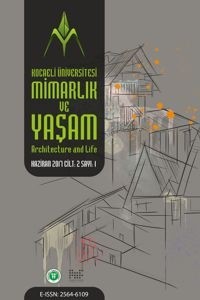İç Mimarlık Eğitiminde Sanal Gerçeklik Uygulamalarının Önemi
Sanal Gerçeklik, Tasarım Eğitimi, İç Mimarlık, VR
The Importance of Virtual Reality Applications in Interior Architecture Education
Virtual Reality, Design Education, Interior Architecture, VR.,
___
- Asanowicz, A. (2022) “Approach to Computer Implementation in Architectural Curriculum”, Proceedings of the 16th International Conference on Education and Research in Computer Aided Architectural Design in Europe (eCAADe), 4–8.
- Baas, J., Schotten, M., Plume, A., Côté, G. ve Karimi, R. (2020) “Scopus as a curated, high-quality bibliometric data source for academic research in quantitative science studies”, Quantitative Science Studies, 1(1), 377–386.
- Bilalis, N. (2000) Computer aided design CAD.
- Dionisio, J. D. N., III, W. G. B. ve Gilbert, R. (2013) “3D virtual worlds and the metaverse: Current status and future possibilities”, ACM Computing Surveys (CSUR), 45(3), 1–38.
- Dunston, P. S., Arns, L. L., Mcglothlin, J. D., Lasker, G. C. ve Kushner, A. G. (2011) “An immersive virtual reality mock-up for design review of hospital patient rooms”, Collaborative design in virtual environments, 167–176.
- Heydarian, A., Carneiro, J. P., Gerber, D. ve Becerik-Gerber, B. (2014) “Towards measuring the impact of personal control on energy use through the use of immersive virtual environments”, ISARC. Proceedings of the International Symposium on Automation and Robotics in Construction, 549–556.
- Heydarian, A., Carneiro, J. P., Gerber, D. ve Becerik-Gerber, B. (2015) “Immersive virtual environments, understanding the impact of design features and occupant choice upon lighting for building performance”, Building and Environment, 89, 217–228.
- Heydarian, A., Carneiro, J. P., Gerber, D., Becerik-Gerber, B., Hayes, T. ve Wood, W. (2014) “Immersive virtual environments: experiments on impacting design and human building interaction”:, Proceedings of the 19th International Conference on Computer-Aided Architectural Design Research in Asia (CAADRIA). Kyoto, Japan, 14–17.
- Liu, D., Bhagat, K. K., Gao, Y., Chang, T.-W. ve Huang, R. (2017) “The potentials and trends of virtual reality in education”, Virtual, augmented, and mixed realities in education, 105–130.
- Maftei, L. ve Harty, C. (2016) “Challenging design perceptions in immersive virtual reality environments?”, 32nd Annual Association of Researchers in Construction Management Conference. Manchester, U.K.
- Mazuryk, T. ve Gervautz, M. (1996) “Virtual reality-history, applications, technology and future”.
- Neo, J. R. J., Won, A. S. ve Shepley, M. M. (2018) “The impact of auditory disorder and visual disorder on message elaboration and self-regulation when presented with psychiatric help-seeking information–A virtual reality study”, Proceedings of the Design Communication Conference. USA, 511–518.
- Ölmez, D. (2018) The role of virtual environments in architectural design education: Spatial perception and distant collaboration. Yaşar Üniversitesi, İstanbul.
- Özdemir Işık, B. (2017) “Bilgisayar destekli tasarım programlarının mimarlık eğitimine katkısı”, Contribution of computer-aided design programs to architectural education, 10(51), 778–783.
- Persson, J., Dalholm, E. H. ve Johansson, G. (2014) “Informing hospital change processes through visualization and simulation: a case study at a children’s emergency clinic”, HERD: Health Environments Research & Design Journal, 8(1), 45–66.
- Pimentel, K. ve Teixeira, K. (1993) Virtual reality: Through the new looking glass. New York.
- Uzun, K. (2011) “Mimarlık eğitiminde kullanılan dijital tasarım programlarının bellek ve tasarım sürecine katkıları.”, Akademik Bilim’11-XIII. Akademik Bilişim Konferansı Bildirileri. Malatya, 841–850.
- Wingler, D., Joseph, A., Bayramzadeh, S. ve Robb, A. (2020) “Using virtual reality to compare design alternatives using subjective and objective evaluation methods”, HERD: Health Environments Research & Design Journal, 13(1), 129–144.
- Wingler, D., Machry, H., Bayramzadeh, S., Joseph, A. ve Allison, D. (2019) “Comparing the effectiveness of four different design media in communicating desired performance outcomes with clinical end users”, HERD: Health Environments Research & Design Journal, 12(2), 87–99.
- Yıldırım, T., İnan, N. ve Yavuz, A. Ö. (2011) “Mimari Tasarım Eğitiminde Geleneksel ve Dijital Görselleştirme Teknolojilerinin Karşılaştırılması”, Bilişim Teknolojileri Dergisi, 17–26.
- ISSN: 2564-6109
- Başlangıç: 2016
- Yayıncı: Kocaeli Üniversitesi
Safranbolu Eski Çarşı Bölgesinde Mekanın Tüketim Ekseninde İrdelenmesi
Sebile Merve ÖZTÜRK, Ruşen YAMAÇLI
Yüzen Evlerde Sürdürülebilirlik Kavramı
Filiz TAVŞAN, Sümeyye PERVANOĞLU, Cengiz TAVŞAN
Ekolojik Binaların Sürdürülebilir Tasarım Kriterleri ve Değerlendirme Süreci
Ahmet Necip BELEK, Ruşen YAMAÇLI
Biyomimetrik Yapı Malzemeleri ile Post Pandemik Döneme Uygun İç Mekanlar Tasarlanması
Osmanlı İmparatorluğu’ndaki Demiryolu Seferberliğinin Konya Vilayeti Üzerindeki Kentsel Etkileri
Van Kent Yapı Stokunun Mimari Özellikleri ve Mühendislik Uygulamaları Üzerine Bir Değerlendirme
Mimarlıkta Yapı Dersleri Müfredatı Dijital Dönüşüm Modeli
Tayibe SEYMAN GURAY, Burcu KISMET
Dolgu Duvarlı Çerçevelerde Sıvanın Deprem Davranışına Katkısı
